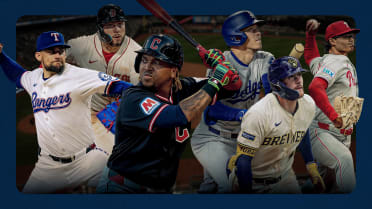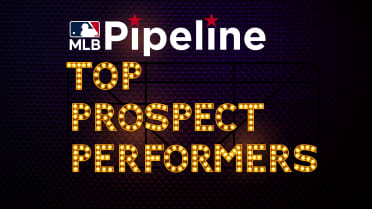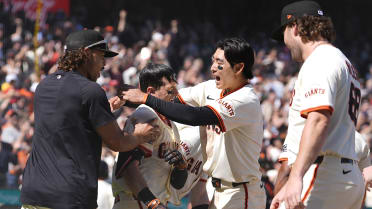Shohei Ohtani hasn't yet thrown one pitch or taken a single swing in American professional baseball, yet the 23-year-old -- often referred to as "the Japanese Babe Ruth" -- has already obtained a somewhat mythical reputation, thanks to glowing scouting reports about his skills on both sides of the ball.
"I've seen players hit a ball 500 feet and players throw a ball 100 mph," said Mariners general manager Jerry Dipoto on a recent edition of his new podcast, referring to Ohtani. "I've just never seen one player do both of those."
• Hot Stove Tracker
Until now, those scouting reports and videos were all we've had to go on, along with the surface-level stats Ohtani collected in parts of five seasons playing for the Nippon-Ham Fighters in Japan's Nippon Professional Baseball. We haven't had the hard data that we're used to seeing for all Major League players, as well as some at lower levels.
:: Shohei Ohtani coverage ::
Until now, anyway, because we've recently been able to obtain Trackman data (the radar system that tracks pitched ball and batted ball movement for Statcast™) for Ohtani's 2017 season. The available data includes approximately 90 percent of the batted balls he put in play in his 231 plate appearances, plus a sample of pitching data from six available starts. Injuries to Ohtani's thigh and ankle limited his time on the mound, so he had just five regular starts and one rehab appearance.
Maybe that doesn't sound like much, but as we like to say, you don't need more than a pitch or two to know that Stephen Strasburg throws hard -- and once you get to a certain level of exit velocity, even doing it once shows evidence of a skill.
So what do Ohtani's data look like? Would you believe two of the biggest comps are an All-Star outfielder and an All-Star starter, each younger than 26 years old? Looking at the data, it appears the scouting reports are made of more than just legends.
On the mound
In 2016, Ohtani set a new NPB record for fastest pitch, reportedly dialing it up to 101.9 mph, and in our available data from 2017, he came pretty close to doing it again. Ohtani maxed out at 101.6 mph, and his average fastball was 97.5 mph, collected from over 250 fastballs. You probably don't need to be told that those numbers are truly elite, yet we're here to do it anyway.
In terms of maximum velocity, 101.6 is pretty close to being off the charts. If we round up to 102 mph, we can see that over the three seasons of Statcast™, only a dozen pitchers have reached that mark. Many of them did it just once or twice; 80 percent of those pitches belong to Albertin Chapman alone. If we narrow it just to starting pitchers, we'll see 102 mph just four times in three years, from Nathan Eovaldi and Noah Syndergaard.
The 97.5 mph average velocity stands out, too. In 2017, we saw 290 starters throw at least 50 fastballs, and Ohtani's mark would have tied for second-best behind Syndergaard with Luis Severino of the Yankees. That's 99th percentile. That's outstanding.
Keep in mind the Severino comparison for a moment, because we have spin-rate data, too. Ohtani's four-seamer averaged 2,301 rpm, and that requires some context. The 2017 Major League average for four-seam spin was 2,255 rpm, and the range among starters who threw 50 goes from 2,590 rpm at the top to 1,821 rpm at the bottom. As we know, high spin can lead to the "rising fastball" effect, which correlates well to swinging strikes and popups; low spin can lead to more sink and more grounders.
Ohtani's ranking here is slightly above average, but relatively close, which means that while it's fast, it might also be straight without a great deal of movement, and we've seen pitchers in the past like Joe Kelly and Eovaldi try the "high-velocity, average-spin" approach, to mixed results. But what should stand out here is that once again, Ohtani's closest comp is Severino, who also had a 2,301 rpm spin.
Severino finished third in the American League Cy Young Award voting in his first full season as a starter, collecting 141 strikeouts on that fastball. It's not a bad name to be compared with. Now, imagine if Severino could hit, too?
At the plate
Ohtani won the 2016 NBP Home Run Derby and once hit a ball into the Tokyo Dome roof so hard that it never came down. In his career, he has slugged .500 in 1,170 plate appearances with 48 home runs. It's clear that Ohtani has power. But how much power? Enough to offset a 27 percent strikeout rate, even in the slightly lower strikeout climate of Japan?
We can't answer that second part just yet, but we do know how hard Ohtani hit the ball in 2017, starting out with the fact that his hardest-hit batted ball was clocked at 111.1 mph. We'll get to the larger averages in a second, but first it's important to realize what a single batted ball of 111 means.
In the Majors in 2017, there were 127,555 tracked batted balls, and only 913 of them were hit as hard as 111 mph -- or fewer than one percent. Again, we're talking about just one batted ball for now, but keep in mind that 436 batters had at least 100 plate appearances in 2017, and 302 of them, or about 70 percent, didn't do it a single time. In the same way that fastball velocity or foot speed or defensive ability is a skill, so is exit velocity. Giancarlo Stanton, who led the Majors by doing it 77 times, has that skill. So does Aaron Judge. So, apparently, does Ohtani.
If we look at Ohtani's averages by batted ball type, we see some interesting names as comparables. On 31 tracked fly balls, his average exit velocity was 94.3 mph, with a maximum of 110.7 mph. The Major League-average exit velocity on fly balls was 91.2 mph, so Ohtani has that beat, and of the 375 hitters who had at least 25 fly balls, his 94.3 would have ranked 50th, or in the top 13 percent.
That's very similar to Freddie Freeman, Yoenis Cespedes and Joc Pederson, and Pederson seems like a pretty good comp, as a young left-handed bat with big power and high strikeout numbers.
On line drives, where Ohtani had that 111.1 mph laser, his average of 96.6 mph on 30 tracked liners was also well better than the Major League average of 92.9 mph. There were 386 players with 25 liners, and that 96.6 would have ranked 33rd, essentially tied with sluggers Joey Gallo, J.D. Martinez and Anthony Rizzo, and in the top 9 percent.
Those are some pretty elite numbers, and they fall in line with what MLB.com prospect expert Jim Callis said on a recent MLB Pipeline podcast, noting that on the 20-80 scouting scale, Ohtani would have "80 raw power, 65 speed, 80 arm, [and] 50 hit," which sounds exactly right. (Though we don't have raw foot-speed data on Ohtani yet, a recent report had him hand-timed at 3.8 seconds from home to first, which is about the same as Dee Gordon's average "max effort" home-to-first time.)
No matter where Ohtani ends up, he's going to attempt to do something we've never really seen in baseball, because while there's been attempts like Brooks Kieschnick, Micah Owings and Brett Eibner, we haven't seen a real two-way player since Ruth himself. It's an unfair name to compare to a 23-year-old with no Major League experience, obviously. But so far as we can tell, the data indicate that the hype isn't overblown. The skills really do seem that impressive.
Mike Petriello is an analyst for MLB.com and the host of the Statcast podcast. He has previously written for ESPN Insider and FanGraphs.



